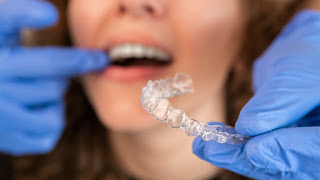Understanding the Investment: Costs Associated with Permanent Retainers
Orthodontic
treatments often include the use of retainers to maintain the alignment
of teeth after braces are removed. While traditional removable retainers are
common, some individuals opt for permanent
retainer cost for a more seamless and continuous solution.
Before deciding on a permanent retainer, it's essential to understand the
associated costs and factors that may influence the overall investment.
What is a Permanent
Retainer?
A permanent retainer, also known as a fixed or bonded
retainer, is a thin wire that is bonded to the back of the teeth. It is usually
placed on the lower front teeth, although it can be used on the upper teeth as
well. Unlike Removable
Orthodontic that can be taken out, permanent retainers provide a
continuous means of maintaining the corrected alignment of the teeth.
Factors Influencing
the Cost:
1. Material Used
- The material of
the wire used for the permanent retainer can affect the cost. High-quality
materials may be more durable but come at a higher price.
2. Location and Provider
- The cost of
orthodontic procedures, including the placement of permanent retainers, can
vary based on geographical location and the specific orthodontic provider.
Urban areas and specialized orthodontic practices may have higher fees.
3. Insurance Coverage
- Some dental
insurance plans may cover a portion of the cost of permanent retainers. It's
crucial to check with the insurance provider to understand the extent of
coverage and any out-of-pocket expenses.
4. Follow-up Appointments
- Regular follow-up
appointments with the orthodontist are necessary to monitor the condition of
the permanent retainer. These appointments may involve adjustments or repairs,
contributing to the overall cost.
5. Additional Procedures
- If additional
procedures, such as dental cleanings or repairs, are needed during the time of
wearing the permanent retainer, they can add to the overall cost.
Benefits of Permanent Retainers:
1. Continuous Maintenance:
- Permanent
retainers offer a continuous means of maintaining the corrected alignment of
teeth, reducing the risk of relapse.
2. Convenience:
- Since permanent
retainers are fixed in place, there is no need for the wearer to remember to
put them in or take them out.
3. Less Visibility:
- Being on the back
of the teeth, permanent retainers are less visible than removable ones,
providing a more discreet option.
Conclusion:
The decision to invest in a permanent retainer involves considering both the benefits and costs associated with this orthodontic solution. Consulting with an orthodontic professional can provide valuable insights into the specific needs and potential expenses involved. While the initial cost may be a factor, the long-term benefits of maintaining a straight and aligned smile can make the investment worthwhile for many individuals.


Comments
Post a Comment